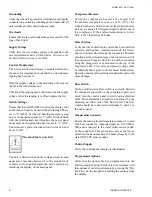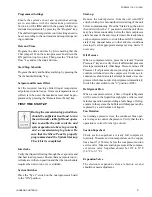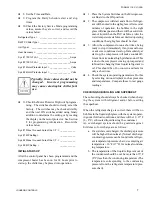
CHECkIng ECOnOmIZER SUPERHEAt
(IF APPLICABLE) (15 tOn tXV)
The economizer superheat should be checked to assure
proper economizer operation and motor cooling. Correct
superheat setting is approx. 10 - 12°F (6 - 7°C).
The superheat is calculated as the difference between
the pressure at the Economizer Service Valve on the
compressor converted to the corresponding temperature
in a standard pressure/temperature chart and tempera-
ture of the gas at the bulb on the entering piping to the
motor housing.
Example:
Motor Gas Temp =
90°F (32°C)
minus Economizer Press
139 PSIG converted
to Temp - 78°F (26°C)
12°F (6°C)
Normally, the thermal expansion valve need not be
adjusted in the field. If however, adjustment needs to
be made, the expansion valve adjusting screw should
be turned not more than one turn at a time, allowing
sufficient time (approximately 15 minutes) between
adjustments for the system and the thermal expansion
valve to respond and settle out. Assure that superheat is
set between 10 - 12°F (6 - 7°C).
1. Record the motor gas temperature, economizer
pressure, economizer pressure converted to
temperature, and economizer superheat below:
SYS 1 SYS 2
Economizer Press =
PSIG (kPa)
Economizer Temp =
°F
(°C)
Economizer Press
Converted to Temp =
°F
(°C)
Superheat =
°F
(°C)
This superheat should only be checked
in an ambient above 90°F (32°C).
Otherwise, mid-range adjustment (fac-
tory setting) is acceptable. Below 90ºF
(32ºC) ambient, the economizer will
not provide additional subcooling.
LEAk CHECkIng
1. Leak check compressors, fittings, and piping to
assure no leaks.
If the unit is functioning satisfactorily during the initial
operating period, no safeties trip and the compressors
load and unload to control water temperature, the chiller
is ready to be placed into operation.
©2009 Johnson Controls, Inc.
P.O. Box 423, Milwaukee, WI 53203
www.johnsoncontrols.com
Printed in USA 201.19-CL1 (309)
New Release



























